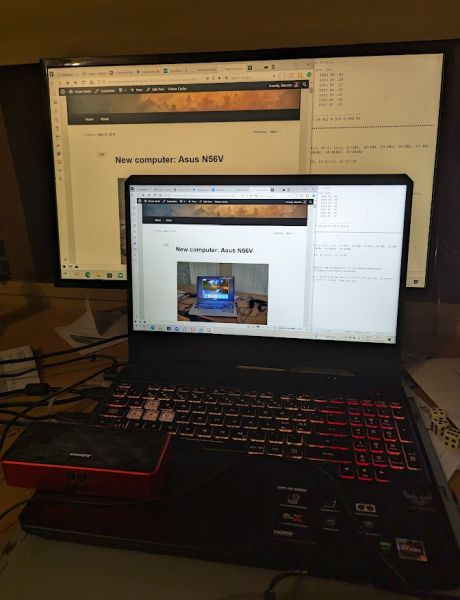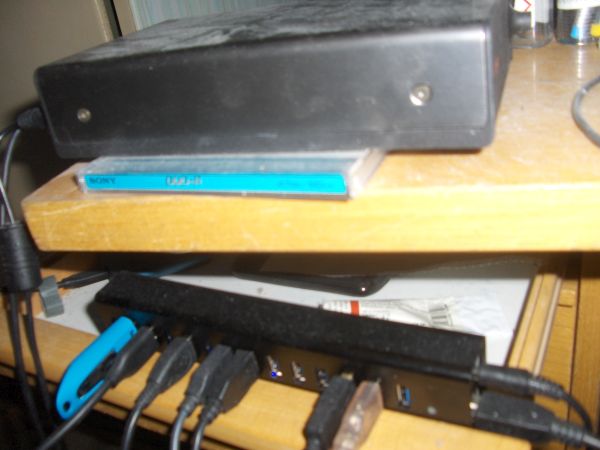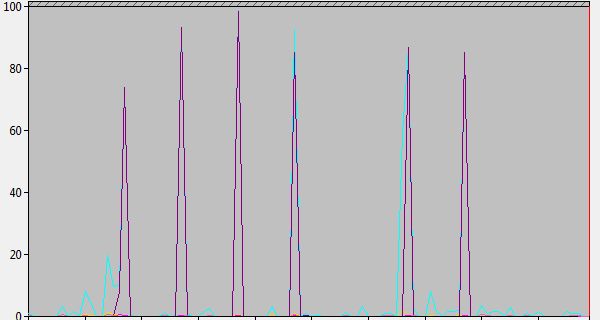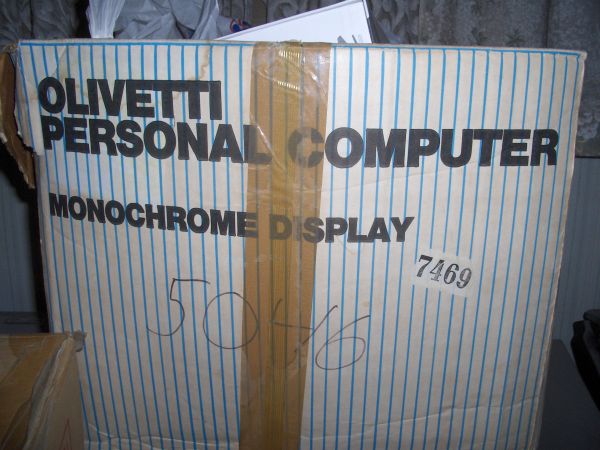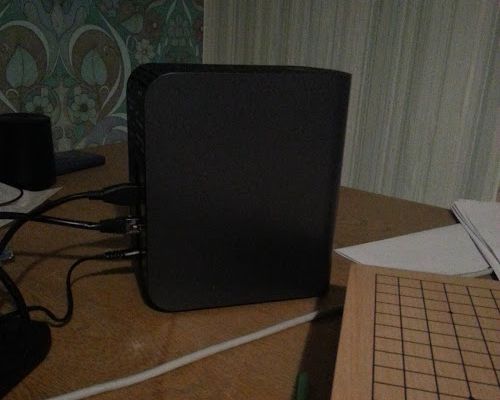
6 terabytes. I love living in the future. I remember when that black box would have filled a room and heated the whole house in midwinter.
There are already various professional reviews out there on the Net, so I thought I would write something a little more personal (but not embarrassingly so, I hope!).
NAS? What’s NAS? I did not know either as late as last year. It means “Network-Attached Storage.” Basically it is a tiny computer with a big hard disk (or two big disks, in the case of the Duo). You plug it into your home network (or small business, although this is clearly meant for the home). If you don’t have a network, that’s OK too. When you connect it to your Windows, Linux or Mac computer using the enclosed cable, a network should automatically arise.
I actually don’t use a router, just a switch that connects the computers to each other and the NAS, and it works just fine whether there is one or more. The three computers I have tested it with run Windows 7, Windows Vista, and Ubuntu Linux. The enclosed CD maps the NAS disk up as a network drive in Windows. In Linux, you just find it in Places – Network and start using it. A good thing, since my tiny netbook does not have a CD drive!
Out of the box: The NAS is so lightweight, a man can hold it easily in one hand. I remember back when 6 terabytes (million megabytes) would have filled a room and heated the whole house in midwinter. The future is amazing, isn’t it? It has finally arrived!
The first thing I did was connect it to the mains. It came with a tree-prong head, but I soon figured out how to pop that off and replace it with the enclosed two-prong. It does not even need to be grounded, and it figures out on its own what voltage it is connected to and adjusts automatically.
While the machine was spinning up, I attached the network cable and plugged the other end into the network switch. If you have a router, you should plug it in there. If the router also broadcasts WiFi, you can access the NAS from your laptops, slates and phones wirelessly.
After a couple minutes, the NAS was running. Even before I ran the CD, I could find the NAS under Network, and clicking on the picture of it brought up a menu with help for setting it up. You don’t need to do that, it works fine right out of the box. If you are the only person who will use it, or if you have nothing to hide, you can login as admin without a password and just use the public shares.
Users, shares and devices: I set up a separate user for myself and one for Tuva the Imaginary Woman. I gave each of us a private share in addition to the public ones. What is a share? Basically it is a top-level folder on the hard disk of the NAS. You can have many of these, and they can be public or private. The system comes with some public shares set up already, for things like photos, music and video. But if you have deep dark secrets that you don’t want to share with others, you can have private shares as well. It took me only a little fiddling to hide my private share from my Imaginary Other, and the other way around. You can also have shares that are owned jointly by parents but not children, or other arbitrary groups of users. If you are using the NAS in a business, this suddenly gets more serious, but it is still quite simple.
So shares are only loosely tied to users. You can have many of each, and they don’t need to be one on one. A user can have many shares, a share can have many users. Or not. It is up to the Admin, the first account that meets you the first time you log on the Duo.
Devices is a bit different. As long as you are in your home (or small business) network, you can log on any user from any machine. Remote logon is slightly more complicated. You have to explicitly create a web access account for an existing user if you want them to log in over the Internet. The procedure requires their email address, which will get a mail with the instructions to create a new password. This comes in addition to the password they would have used if they were physically at the home network. (The two passwords can be the same, if they are strong enough to be accepted.) Once the user has created this password, they can log in from any computer on the Internet. (Whether they should is another matter. The solution as it stands today is based on Java, which is as full of security holes as a Swiss cheese, or so the experts say.)
Adding a mobile device is a separate action. It also requires an existing user. You can have web access but not mobile access, or the other way around. Mobile access also requires an app; in the case of Android it is named WD2go (Western Digital to go, OK?) and is free on Google Play. It is simple and straightforward to use, but you first have to register it using a 12-digit code that must be generated on the NAS. This means that even though I downloaded the app at work, I could not register it until I came home and could connect directly to the Duo on the home network. The app allows not only streaming of music but also of video. You should have a pretty new and powerful device to do that, though. And even then it will wait some seconds before it starts playing a song, and even more before playing video.
So each user can have multiple mobile devices but they must be registered separately, whereas on a PC you can log on your account from any computer once you have been set up with web access.
Extreme expansion: The third hole in the back of the Duo was for a USB cable, but contrary to my first imagination you can not use this to connect it to the PC like I did with my long row of external disks (half of which died horribly before the warranty expired, sometimes in mere months). Over time the external hard disks became gradually more robust, and my 1.5 TB Samsung has proved quite a reliable companion. But now that I have the NAS, which is built for heavy duty, it is time for the Samsung USB disk to retire. I gave it one final chance to shine though: Plugging its USB cable into the back of the Mybook Live Duo, it suddenly showed up on all my PCs simultaneously as a share within the NAS, without me having to do anything extra. You can even use a USB hub and connect all your old external disks and memory sticks, and make them all available to the whole family (or office), as well as friends and family all over the world on the Internet.
There are probably limits to how much extra storage you can add this way, but I am not sure what the limit is. I added 1.5 TB, but there are 2 TB disks available at affordable prices, and the documentation explicitly states that you can use a USB hub to connect multiple devices.
In theory I could just let things stay that way and continue to use the Samsung. I mean, it is Samsung, so it probably won’t keel over dead easily. But just in case, I am currently copying the contents to the NAS. That way I can just keep the old disk as a backup. A NAS is made for heavy duty, or so I am led to believe. It is not a backup solution, but more like the servers of a corporate network, where you want the data to lie on the server and not on each PC.
Speed, or lack thereof: Copying takes its sweet time though. I blame the USB 2.0, the system told me it would take 19 hours to copy 1 TB from the old disk to the new. That’s a lot of time, but then it is a lot of data. A letter page with typewriter text is about 4000 characters. 1 TB is a million million characters, or a thousand billions. There are just over 7 billion humans in the world today. So I could write a short description of each of them to make a terabyte. We’re not quite on the same order of magnitude as the US national debt, though. Perhaps with the next generation of NAS!
Copying from my laptop over the network cable was actually quite a bit faster than copying from the USB disk, but still took some time for large folders. Like the MP3 files I ripped from my hundreds and hundreds of CDs before throwing them away. 12.6 gigabytes of data I have legally bought and paid for. Unfortunately so, in many cases, since most non-Irish CDs have only 1-2 good songs and the rest filler. The least I can do is share them with family and friends. (In Norway this is actually legal, although the definition is pretty strict.) And with my new NAS, I can do that without publishing it to the whole Internet. Another question is whether my family and friends want to hear my music, given that even I only do so sporadically.
One final thought before I close. Even when I am not copying anything to and from or between the WD NAS and the Samsung, they are both blinking frenetically, as if they were busy moving stuff around. What’s up with that? Back when the Samsung was attached to the laptop, it would go to sleep after a few minutes of inactivity. So I assume it is the small computer in the NAS which is doing something, but I don’t know what. Indexing? Quality checking? Defragmenting? Pointless running in circles? I will probably never know.
[Edit to add: Two days later I woke up in the morning and both of the disks had quieted down. I noticed that copying from the Samsung to the WD now seemed to go a little faster. So probably it had done something useful, like indexing or defragmenting.]
But even with that, I am impressed. Not quite indistinguishable from magic, but close enough. I love living in the future, and that future is now well within reach of the working classes here in Norway.
